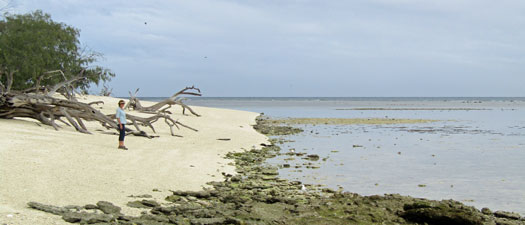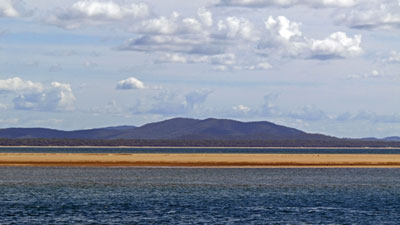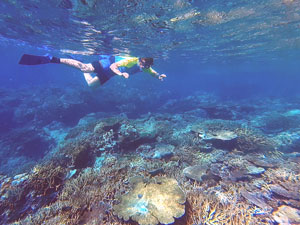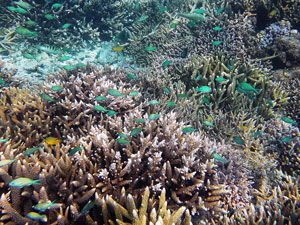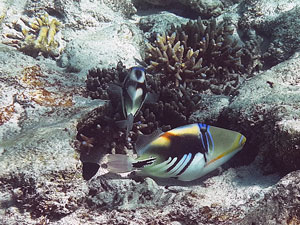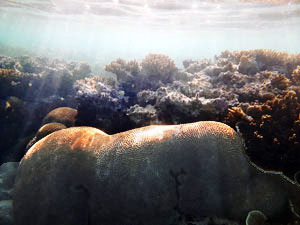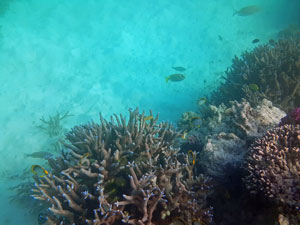| Lady Musgrave Island |
About |
We've come to the coastal village of Agnes Waters on the central Queensland Coast. The main reason for this is to camp for four nights on Lady Musgrave Island, a 14 ha sand cay surrounded by a reef-enclosed 1200 ha lagoon. Lady Musgrave is part of the Capricornia Group, a series of isolated reef-fringed coral cays that form the southern end of the Great Barrier Reef. Situated 60 km off the coast, it is one of the few cays that you can camp on.
|
||
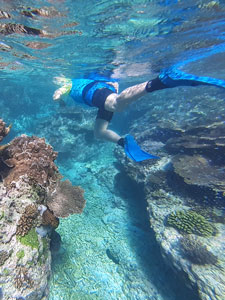 |
|
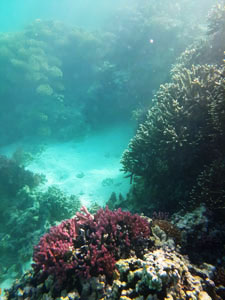 |
To camp on such an island way out in the Pacific Ocean has long been a dream of ours - its time that dream was realised. |
|
| Short walks around Agnes Waters and Seventeen-Seventy (11 km) |
Before heading out to Lady Musgrave, we spent a few days in a roomy cabin on the beach at Agnes Waters - time to relax after the last kayaking adventure and time to prepare for our camping trip to the island. However, being a bit of coastal walk aficianados, we couldn't stay here without at least a couple of short walks to check out the local coast line. |
|
 Looking north towards Agnes Waters from the promontory |
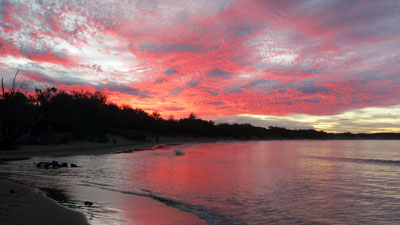 Agnes Waters sunset |
 Promontory at the southern end of Agnes Waters Beach |
The first was a late afternoon walk from our accommodation at Agnes Water Beach up to a lookout point on a rocky promontory to its east. This was part of the Discovery Trail which led through the scrubby eucalypt forest to various viewpoints and beach accesses. We followed the path along before cutting down a worn gully track to a tiny beach, nestled between the rough orange rocks of the headland. |
 Rocky coastline south of Agnes Waters |
From it, we clambered over a couple of protruding rocky spurs to reach Workmens Beach, a sweeping stretch of tan-coloured sand, ending at a rocky knob. Then it was back home via the inland track, through the forest to complete this small circuit and gain a better appreciation of the coastal landscapes in this area. |
||
 On the Discovery Trail |
 The tan sand of Workmens Beach |
 Agnes Waters Twilight Agnes Waters Twilight |
After returning from Lady Musgrave Island, we did another short walk (7 km) - this time to Round Hill Headland, which protects the estuary at Seventeen-Seventy. It was an excellent way to finish our stay here. |
||
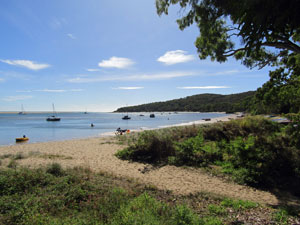 View from the shore-line of Seventeen-Seventy |
 Memorial to Captain Cook's landing in 1770 |
 Mangroves lining the shore |
The walk took us from the marina along the edge of the estuary, with its tan sand beaches and scattered patches of mangroves. Boats lolled at their moorings in the protected waters of the estuary, while the flat sand bars within it were framed by the blue hills beyond. Seventeen-Seventy sits in a beautiful setting.
|
Eventually the track headed up into the forest of the headland, following it along past several tiny beaches nestled between the rocks and the palms and pandani. |
|||
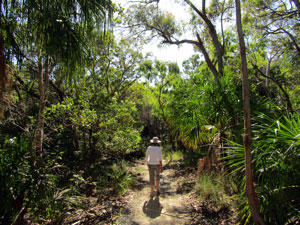 In the coastal forest |
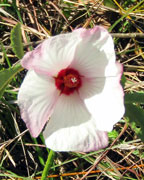 |
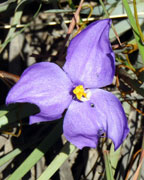 |
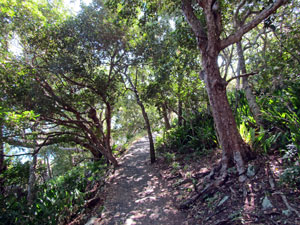 The track out to the headland |
 Waving palms .... |
 .... red rock cliffs .... |
 ....and lovely ocean views |
|
We took a short cut past one such beach to climb up to the main track and head out to a viewpoint near the tip of the headland, with its rugged orange-tinted rocks. Here we were exposed to the winds and could look out at the surf below, where a small pod of dolphins frolicked. |
|
 The estuary at low tide |
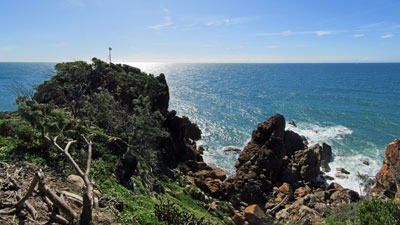 The rugged rocks of Round Hill Headland |
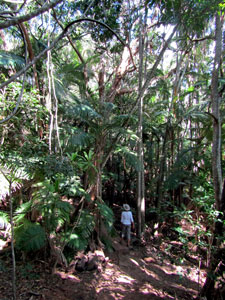 Track through a patch of rainforest |
|
 View towards the moutn of the estuary |
Then it was time to return, completing a small loop and side trip on a narrow footpad to a viewpoint over the estuary, its sandy shoals and background of distant hills, before retracing our footsteps back to the car park. We could see why, in 1770, Captain Cook would have anchored in the calm waters of this estuary after pushing his way up the east coast of the continent with its strong winds and swells. |
||
|
Lady Musgrave Island (60 km by boat from the mainland) |
 Moon over 1770 |
We were up before 5am - time to get to the marina at Seventeen-seventy for a 6am rendezvous to travel out to Lady Musgrave Island. We needed to be at the island on a full tide to enable disembarking by dinghy. The full moon was low in the sky, reflecting its light across the estuary water, as we wandered down to board our boat, "Bulletproof", a double-hulled 10m ex-water police boat, skippered by Tony with his wife Sandy as crew. We had dropped off most of our gear the previous day and were all ready for departure. Our fellow passengers were a family of five, David and Ruth, and their children, Aaron, Sky and Louis. We were all set for 4 nights camping on the island. We set out on the smooth waters in the protected estuary, but, as soon as we passed the headland, we found ourselves motoring into a south-easterly swell and strong wind. It was rocking and rolling time for the 60 km trip across open sea to Lady Musgrave. - enough for three passengers to succomb to sea-sickness (fortunately, not us). |
 Setting out in the pre-dawn light |
Some two and a half hours later, we saw the profile of the tiny coral cay on the horizon and the waves subsided as we reached its lee side - the dinghy rides from boat to shore with passengers and gear would be easy. We had arrived. |
||
 Arrival at Lady Musgrave Island |
 The local residents welcome us |
 Campsite amongst the pisonias |
Out here in the ocean, the clear sky of the mainland had been replaced by grey cloud, but the weather was a warm 22°C. The sea temperature was the same. The camping area stretched along the white sand beach, well-protected from the prevailing winds, and we found a nice tent site nestling into the pisonia trees while looking out across the sea to the nearby Fairfax Islets - our own little bit of beachfront paradise. |
|
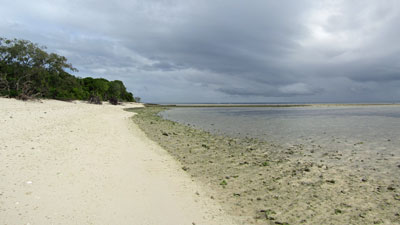 The beach at Lady Musgrave campsite |
 Tide's out on the fringing reef |
Above us, the noddies rested noisily in the pisonias and several buff-banded rails scurried about the campsite, investigating the new arrivals and their gear. This was their territory and they would be our companions for the remainder of our stay. |
|||
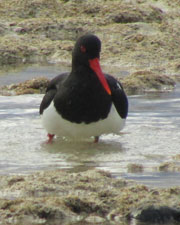 |
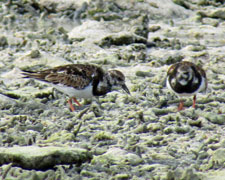 Birds of .... |
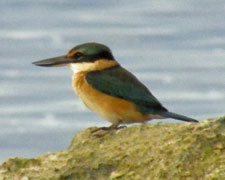 .... the reef |
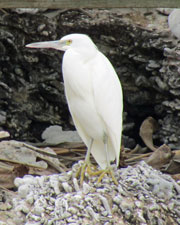 |
Thus began a lazy first day, with the occasional brief rain shower - time to wander around the cay and get our bearings, explore the reef near our campsite at low tide, watch as the tide raced in again to cover the reef flats near our campsite and finally enjoy the flights of thousands of noddies returning from a day at sea - an erratic plume of seabirds arriving as the sun set to roost in the island's pisonia forest. |
||
 |
 Creatures of the exposed reef |
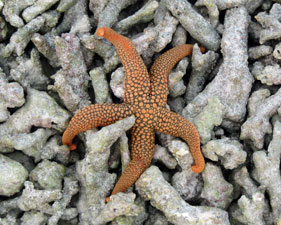 |
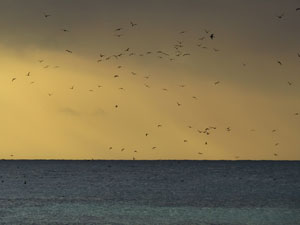 Evening flight of noddies |
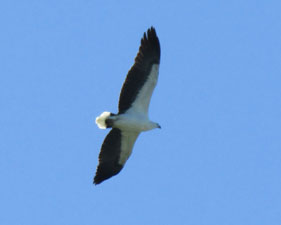 |
 Relaxing in the cool of the evening |
For the first time on our trip, we sat out to eat our dinner and didn't feel cold. What an idyllic place this is. |
||
|
Lady Musgrave Island - Days 2 to 4 |
There is a powerful aura of inertia about a small sandy cay in the middle of an ocean. We immediately felt life slowing down and easily let ourselves slip into this new tempo. After a cloudy arrival, we had several days of bright sunshine - perfect. |
||
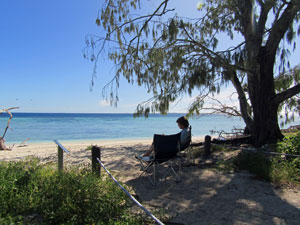 |
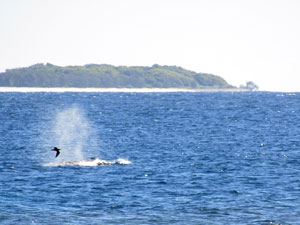 Humpback whale cruising through the channel |
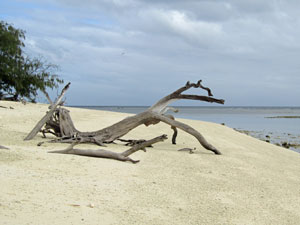 |
Thus passed the days - breakfast looking out over the sea to the flat tree-topped profile of the Fairfax cays, entertained by the antics of the rails, who roamed nonchalantly around our feet, chased each other through the bushes and even picked the odd full-on fight if another rail dared encroach on the territory. In fact, this happened every meal - I'll miss these birds. |
||
 |
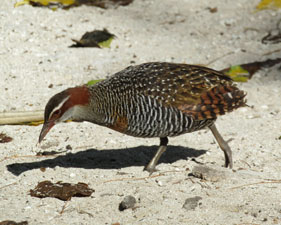 The campsite superintendent |
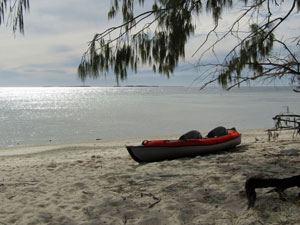 |
The days were filled with snorkelling - on the reef flats at high tide or the sloping outer reef near our campsite with its channels and gutters at low tide, and in the lagoon with its reef walls and deeper sandy bottoms. These reefs supported a variety of corals and brightly coloured fish. |
||
|
|
|
|
|
|
The birdlife here was definitely a feature of the island - tiny silvereyes flitting from bush to bush, kingfishers watching the tidal pools to swoop on the unwary fish, herons and egrets stalking fish in their own way, an imperious sea-eagle surveying its domain and, of course, the thousands of noddies that call this place home. This of course meant that the nights were passed listening to the symphony of noddies in the pisonoas above, from high pitched whistles to guttural cackles. Such is the sound of Lady Musgrave. Curiously, in the early morning, they were quiet. I did ask one why carry on all night long and stop when the sun came up, but it didn't deign to reply. |
|||
 |
 |
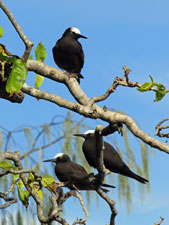 |
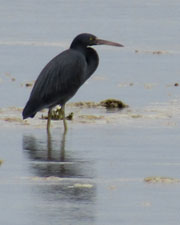 |
One pleasure was to watch the brilliant sunsets over the ocean with a cold beer, as long flights of noddies flew in from the west to roost after a day at sea. |
|
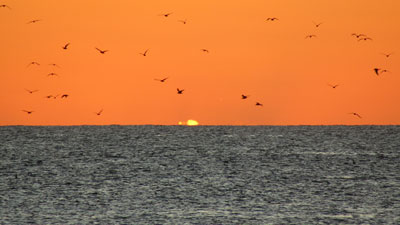 The flight of the noddies |
 Just another glorious sunset across the reef |
One day, we inflated our kayak to paddle around the sandy cay and out into the huge 1200 ha lagoon, checking out some of the moored catamarans and yachts as well as the floating pontoon used by tourist boats. Out on this huge expanse of relatively calm water, protected by a fringing reef, it didn't seem like we were in the midst of the Coral Sea, 60 km from th mainland. |
||
 Time for a paddle .... |
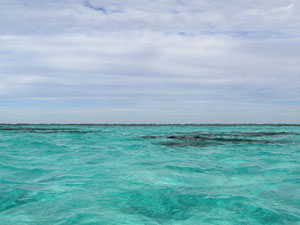 .... in Lady Musgrave lagoon |
 Passing the moored pontoon |
 |
 Lady Musgrave Island from out in the big lagoon |
 |
Walks beneath the shady canopy of the gnarly pisonia forest, fringed on its windward edges by casuarinas and pandani, or a stroll onto the reef at low tide offered bits of activity between reading books or just watching the sea-life cruise by - green turtles and a reef shark in the shallows close to shore and a couple of humpback whales further out to sea. Thus went our inertia |

